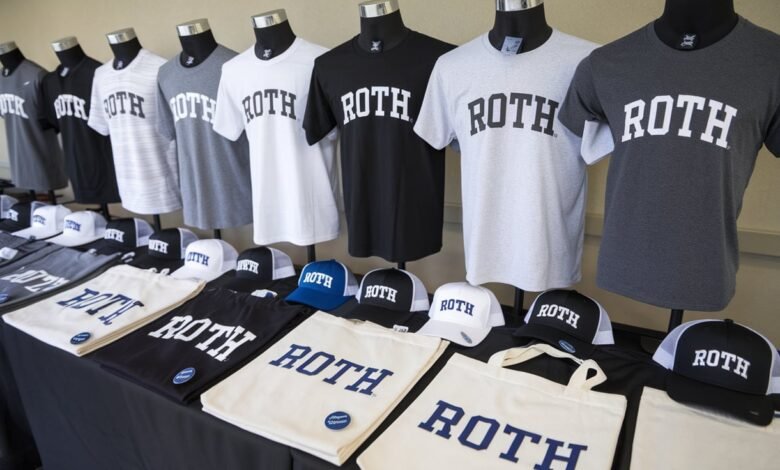Understanding Roth Merchandise Planning: A Comprehensive Guide

Introduction to Roth Merchandise Planning
Roth merchandise planning is an essential strategy in the retail and merchandise management landscape that focuses on optimizing product assortment, inventory levels, and sales projections. This systematic approach assists retailers in aligning their offerings with market demand, ensuring that the right products are available at the right time. Effective merchandise planning not only streamlines operations but also plays a significant role in driving sales and enhancing customer satisfaction.
The significance of Roth merchandise planning lies in its ability to facilitate informed decision-making. By analyzing consumer behavior, seasonal trends, and market conditions, retailers can develop a robust merchandise plan that addresses customer preferences while maximizing profitability. This involves creating a balanced product mix that considers various factors, such as price points, quality, and brand relevance. The goal is to maintain optimal inventory levels that meet consumer demand without incurring excess stock or potential markdowns.
Key concepts within Roth merchandise planning include assortment planning, inventory management, and sales forecasting. Assortment planning entails selecting the right mix of products that cater to diverse customer needs, while inventory management ensures that stock levels are effectively monitored and adjusted in response to sales patterns. Sales forecasting predicts future sales trends, enabling retailers to make proactive decisions about product replenishment and promotional strategies.
Incorporating effective Roth merchandise planning practices can significantly enhance operational efficiency. By streamlining processes and minimizing waste, retailers can allocate resources more effectively, resulting in improved profitability. Furthermore, creating a cohesive merchandise strategy enables retailers to respond swiftly to market changes, ensuring that they remain competitive in a dynamic retail environment. Ultimately, the successful implementation of Roth merchandise planning is instrumental in achieving long-term business growth and customer loyalty.
The Importance of Effective Merchandise Planning
Effective merchandise planning is an integral component of retail and inventory management, directly influencing a business’s operational success. One of the primary benefits of proper merchandise planning is enhanced inventory management. By accurately forecasting demand, businesses can minimize excess stock while ensuring that popular items are readily available, thereby reducing the risk of lost sales due to stockouts. The careful organization and monitoring of inventory levels streamline supply chain operations and create efficiencies that can lead to significant cost savings.
In addition to optimizing inventory, effective merchandise planning plays a crucial role in improving cash flow. By predicting customer preferences and trends, companies can make informed purchasing decisions that align with consumer demand. This alignment minimizes the need for markdowns, which can erode profit margins. Furthermore, maintaining optimal inventory levels allows for better allocation of financial resources, enabling businesses to invest in other areas, such as marketing or product development.
Another important aspect of merchandise planning is its impact on customer satisfaction. A well-executed merchandise strategy ensures that customers find the products they want when they want them, thereby enhancing the overall shopping experience. Satisfied customers are more likely to become repeat buyers, leading to increased customer loyalty and a stronger brand reputation. Roth merchandise planning embodies these principles by providing structured frameworks that facilitate strategic product selection and assortment planning, further driving customer satisfaction.
Ultimately, effective merchandise planning contributes to greater profitability. By managing inventory wisely, ensuring cash inflows remain steady, and delivering what customers desire, businesses can strengthen their bottom line. Adopting principles of Roth merchandise planning not only enhances operational efficiency but also fosters long-term growth and success in a competitive market.
Key Components of Roth Merchandise Planning
Roth merchandise planning encompasses several critical components that collectively enhance a retailer’s ability to effectively manage its product offerings. These elements are foundational to ensuring that the right products are available at the right time and place, optimizing both customer satisfaction and profitability.
One of the primary components is demand forecasting. Accurate demand forecasts are essential as they help retailers predict consumer behavior and anticipate the need for specific products. By analyzing historical sales data, market trends, and seasonal fluctuations, businesses can make informed decisions regarding the quantity and timing of inventory purchases. This proactive approach prevents stockouts and minimizes excess inventory, thus sustaining a more efficient operation.
Another vital element of Roth merchandise planning is inventory management, which involves tracking stock levels, ensuring product availability, and minimizing waste. Effective inventory management allows retailers to maintain an optimal balance between supply and demand, ultimately leading to improved cash flow and reduced holding costs. Employing inventory management systems can further streamline this process, providing real-time data analysis and insights for better decision-making.
Vendor relations also play a significant role in successful Roth merchandise planning. Establishing strong partnerships with vendors enables retailers to negotiate better terms, quality products, and favorable lead times. Collaboration between retailers and vendors fosters innovation and responsiveness, ensuring that the product assortment aligns with market demands and customer preferences.
Pricing strategies are crucial, as they directly impact sales and profitability. Retailers must analyze competitive pricing, customer sensitivity, and cost structures to develop pricing strategies that attract consumers while ensuring margins are maintained. This consideration often requires ongoing adjustments to remain responsive to changes in market dynamics.
Finally, a well-thought-out product assortment is essential in Roth merchandise planning. The selection of products offered must cater to targeted customer segments, fulfill their needs, and reflect current market trends. By continually assessing and refining the product assortment, retailers can enhance their appeal and deepen customer loyalty, which is vital for sustained success in the competitive retail landscape.
Steps Involved in Roth Merchandise Planning
The process of Roth merchandise planning is a structured approach that consists of several key steps, each contributing to the overall efficiency and effectiveness of merchandise management. The first step is market research. This involves gathering and analyzing data regarding consumer preferences, market trends, and competitor strategies. Understanding these aspects allows businesses to make informed decisions and align their merchandise offerings with customer demands.
The next step is setting goals. Clearly defined objectives are essential for guiding the Roth merchandise planning process. These goals should be specific, measurable, achievable, relevant, and time-bound (SMART), providing a framework to evaluate progress and success. Organizations should consider both short-term and long-term goals that align with their broader business strategy.
Once goals are established, analyzing data becomes a crucial step. Retailers must examine historical sales data, inventory levels, and other relevant metrics to identify patterns and opportunities. This analysis provides insights that inform the development of appropriate merchandise strategies, ensuring that offerings are tailored to meet consumer needs effectively.
Following the analysis, developing strategies is the next phase. This can include decisions on product selection, pricing strategies, promotional activities, and distribution methods. A well-thought-out strategy should account for both market conditions and organizational capabilities, facilitating successful implementation.
The implementation of the plan involves executing the developed strategies and ensuring that all necessary resources are allocated accordingly. This may include training staff, optimizing supply chains, and launching marketing campaigns. Successful execution is paramount to the overall success of Roth merchandise planning.
Finally, monitoring results is essential to evaluate the performance of the merchandise plan. By comparing actual performance against established goals, businesses can identify areas for improvement. Continuous monitoring and adjustment to the Roth merchandise planning process ensure that it remains relevant and effective in a dynamic retail environment.
Tools and Technologies for Roth Merchandise Planning
In the contemporary landscape of retail, effective Roth merchandise planning hinges on the utilization of robust tools and technologies that streamline operations and enhance decision-making capabilities. Among the primary tools are advanced analytics platforms that enable retailers to interpret vast amounts of data related to customer preferences, purchasing behaviors, and market trends. By leveraging these analytical insights, businesses can optimize their inventory levels, forecast demand more accurately, and ultimately align their product offerings with consumer expectations.
Another essential component of Roth merchandise planning is the application of sophisticated inventory management systems. These systems provide real-time tracking of stock levels across various sales channels, helping retailers maintain the right balance between supply and demand. This not only minimizes the risk of overstocking or stockouts but also aids in reducing holding costs, thereby improving overall profitability. Integration of these management tools with forecasting software can further augment the effectiveness of inventory decisions, leading to a more agile and responsive supply chain.
In addition to these analytics and inventory solutions, retailers can benefit from using various software applications that facilitate collaboration among different departments. Multi-channel retailing tools can streamline communication between sales, marketing, and logistics, ensuring that all teams are aligned in their strategies. This cohesion is vital for executing Roth merchandise planning successfully, as it allows for quicker response times to market changes and enhances the overall customer experience.
Moreover, technologies such as artificial intelligence and machine learning are increasingly becoming vital in decision-making processes. These advancements enable predictive analytics, which can forecast future trends and customer behaviors based on historical data. Consequently, the adoption of these tools and technologies supports retailers in achieving operational efficiency while executing Roth merchandise planning, positioning them for sustained success in a competitive market.
Common Challenges in Roth Merchandise Planning
Roth merchandise planning plays a crucial role in maintaining the balance between supply and demand while optimizing inventory levels to maximize sales. However, retailers frequently encounter several challenges that can impede the effectiveness of their planning processes. One of the primary issues is inaccurate demand forecasting. Retailers often struggle to predict consumer behavior accurately, leading to stockouts or overstock situations. This discrepancy can result from sudden trends, seasonal fluctuations, or changes in consumer preferences, making it essential for retailers to refine their demand forecasting techniques continually.
Another significant challenge lies in supply chain disruptions. Events such as natural disasters, political instability, or global pandemics can create unforeseen barriers to obtaining merchandise in a timely manner. These disruptions may also impact production schedules, leading to delays that can result in inventory shortages or excesses. To mitigate these risks, retailers must adopt flexible supply chain strategies that allow for swift adjustments in sourcing and logistics based on real-time data.
In addition to inaccurate demand forecasting and supply chain disruptions, maintaining accurate inventory levels poses another hurdle for businesses engaged in Roth merchandise planning. Often, retailers find it challenging to keep track of their stock, leading to either surplus inventory or insufficient stock availability. Implementing advanced inventory management systems can greatly assist in overcoming this challenge, as they provide real-time visibility into stock levels and facilitate timely replenishment.
Lastly, balancing assortment is a pivotal challenge faced during Roth merchandise planning. Retailers must strive to provide a diverse range of products without overwhelming customers with an excess of options. Striking the right balance requires thorough market analysis and an understanding of consumer preferences. Utilizing data analytics can significantly enhance assortment planning, ensuring that product selections align with customer demands.
Best Practices for Successful Roth Merchandise Planning
To achieve effective Roth merchandise planning, organizations must implement best practices that enhance collaboration, data analysis, and adaptability. One of the foremost strategies involves fostering cross-departmental collaboration. Ensuring that different teams, such as marketing, sales, and supply chain management, work together creates a unified approach to merchandise planning. This holistic view allows for a better understanding of product demand, customer preferences, and inventory levels, ultimately leading to more informed decision-making.
Another critical aspect of successful Roth merchandise planning is the regular review and adjustment of plans. The retail landscape is continually evolving, influenced by factors such as seasonal trends, economic shifts, and technological advancements. Conducting periodic assessments of the merchandise plan enables organizations to identify any discrepancies and adapt to the current market conditions promptly. This proactive approach helps maintain alignment with both organizational goals and consumer expectations.
Flexibility is also paramount in Roth merchandise planning. Retailers must maintain the ability to pivot quickly in response to changing market dynamics. By incorporating agile planning techniques, organizations can adjust their merchandise strategies with minimal disruption. This might involve altering product assortments, modifying pricing strategies, or reallocating inventory based on real-time sales data and forecasts.
Leveraging data analytics is another vital practice that complements Roth merchandise planning. Analyzing historical sales trends, customer behavior, and market insights provides valuable information that can inform future merchandise decisions. Organizations should invest in analytical tools that facilitate the examination of various data sets to form a comprehensive understanding of the factors influencing sales performance and inventory management. This data-driven approach can significantly enhance the effectiveness of merchandise planning and ultimately lead to better financial outcomes.
Case Studies: Successful Roth Merchandise Planning Examples
Roth merchandise planning has emerged as an essential strategy for retailers aiming to optimize their inventory and sales processes. Numerous companies have successfully implemented these practices, yielding significant benefits that can serve as benchmarks for others in the retail sector. One notable example is Company ABC, a leading fashion retailer that faced the challenge of declining sales due to poor inventory management. By adopting a robust roth merchandise planning framework, they were able to streamline their supply chain processes. This integration allowed them to analyze trends more effectively and adjust their stock levels to maximize sales opportunities. As a result, they saw a 15% increase in sales within the year following implementation.
Another interesting case is found in Company XYZ, a grocery chain that struggled with excess inventory and waste due to seasonal fluctuations. By leveraging advanced analytics as part of their roth merchandise planning strategy, they were able to forecast demand with greater accuracy. This proactive approach reduced food waste and improved turnover rates in perishable goods, leading to a remarkable 30% decrease in markdowns. The key to their success lay in their willingness to embrace data-driven decision-making, empowering their purchasing team to adjust orders based on real-time sales data.
Additionally, a global electronics retailer, Company DEF, incorporated roth merchandise planning to tackle its challenge of overstocked and outdated inventory. Their strategy involved periodic reviews of their product life cycles and aligning inventory with consumer preferences. Through creating targeted marketing campaigns around specific high-turnover items, they not only cleared out old stock but also increased customer loyalty, evidenced by a 20% boost in repeat purchases. These real-world examples illustrate how adopting effective roth merchandise planning techniques can directly impact sales performance and inventory management, providing a clearer pathway for organizations looking to improve their operational efficiency.
Conclusion: The Future of Roth Merchandise Planning
Roth merchandise planning represents a dynamic field that continuously evolves to meet the needs of an ever-changing market. As we have explored throughout this guide, the successful implementation of this planning requires a strategic approach, incorporating both analytical insights and a deep understanding of consumer preferences. Key takeaways from our discussion highlight the importance of flexibility in planning, the integration of technology, and the value of sustainable practices.
Looking ahead, the future of Roth merchandise planning will undoubtedly be shaped by emerging technologies such as artificial intelligence, data analytics, and machine learning. These tools enable retailers to analyze vast amounts of data, predict trends, and efficiently allocate resources. Furthermore, the integration of cloud-based platforms facilitates collaborative planning processes, allowing teams to access information in real-time and make informed decisions efficiently.
Consumer behaviors are also undergoing significant changes. As shoppers increasingly prioritize sustainability, merchandise planning must adapt accordingly. This includes sourcing eco-friendly products, optimizing supply chains to reduce waste, and promoting transparency regarding sourcing and production methods. Retailers who embrace sustainable practices within their Roth merchandise planning will not only attract a more conscientious customer base but also contribute to long-term environmental benefits.
Finally, ongoing learning and adaptation are crucial components of an effective merchandise planning strategy. As market dynamics shift, businesses must remain agile, continually reassessing their approaches and embracing new methodologies. By maintaining an emphasis on knowledge acquisition and innovation, retailers can position themselves favorably to navigate the complex landscape of merchandise planning and thrive in an increasingly competitive environment. Adapting to these emerging trends in Roth merchandise planning will ensure that businesses remain resilient and capable of meeting future challenges.
You May Also Read This Usamaketime.

